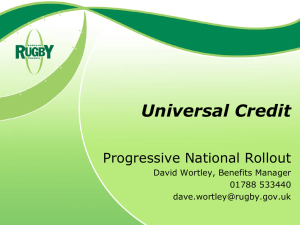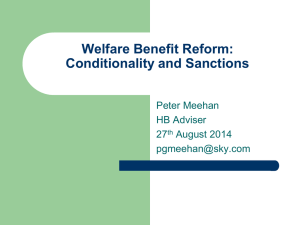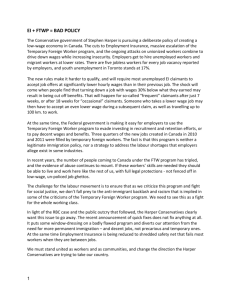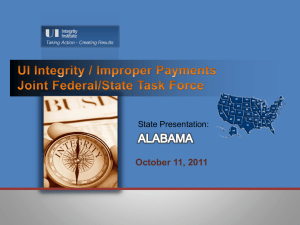Housing Benefit: Size Criteria for People Renting in the Social Rented Sector
advertisement
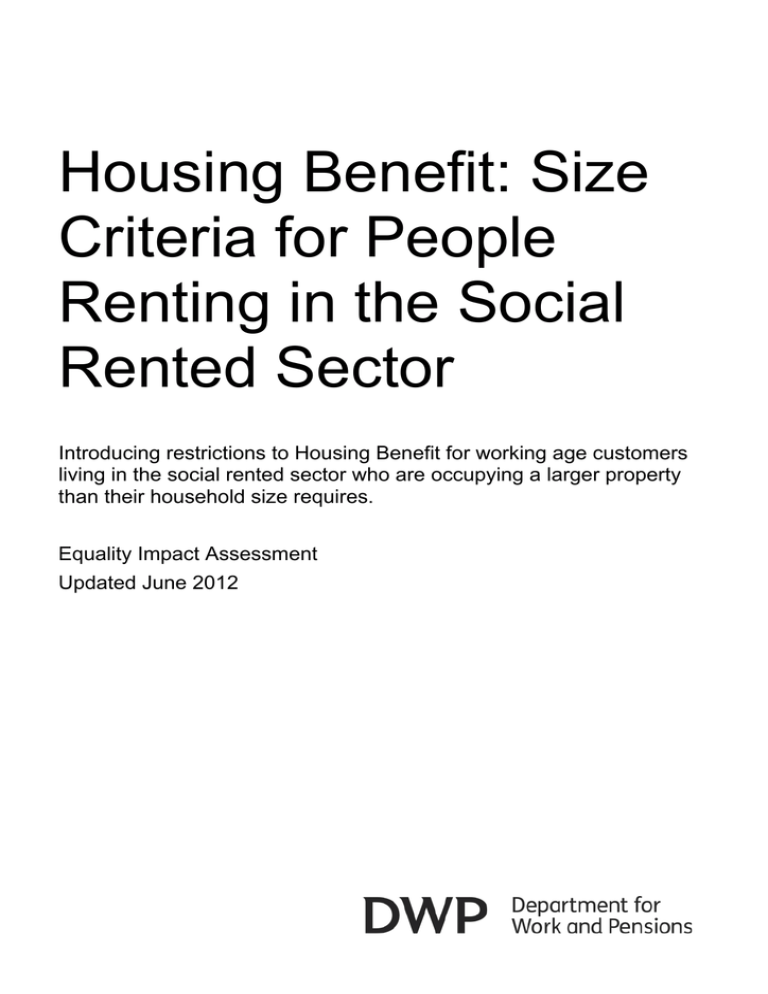
Housing Benefit: Size Criteria for People Renting in the Social Rented Sector Introducing restrictions to Housing Benefit for working age customers living in the social rented sector who are occupying a larger property than their household size requires. Equality Impact Assessment Updated June 2012 Equality impact assessment for introducing restrictions to Housing Benefit for working age customers living in the social rented sector who are occupying a larger property than their household size requires Brief outline of the policy 1. Housing Benefit claimants living in the social rented sector (which includes local authority tenants and tenants of registered providers of social housing and registered social landlords), generally have no restrictions placed on the size of accommodation that they occupy. The amount of Housing Benefit to which they are entitled, and the eligible rent part of the Housing Benefit calculation, is unrelated to the size of accommodation that claimants actually require – it is based simply on the accommodation that they actually occupy. 2. When tenants are placed into accommodation in the social rented sector, the housing needs of the household will be considered by the housing provider. However, these needs may change over time. There is no systematic review to consider whether the accommodation that the tenant has been allocated remains the most appropriate. 3. In a small number of cases, where the claimant is a tenant of a registered provider of social housing or registered housing association, the local authority Housing Benefit service may refer individual cases to the rent officer where the accommodation is considered too expensive or too large for the needs of the claimant and their household. In practice, however, this happens rarely. 4. As a consequence, eligible rent levels for claimants in the social rented sector are not currently determined by reference to the size of the claimant’s household. This is in contrast to the rules that apply in the private rented sector. In the private rented sector, claimants only receive Housing Benefit for accommodation based upon the reasonable accommodation needs of their household. 5. On 1 April 2013 it is intended to introduce size criteria for new and existing working age Housing Benefit claimants living in the social rented sector. The size criteria will replicate the size criteria that apply to Housing Benefit claimants in the private rented sector and whose claims are assessed using the local housing allowance rules. The applicable maximum rent will be reduced by a national percentage rate depending on the number of spare bedrooms in the household. Legislation to allow this is contained in the Welfare Reform Act 2012. 6. A bedroom for a non-resident carer will also be taken into account in determining the relevant size criteria where that carer provides necessary overnight care for the claimant or their partner. 7. The change will only apply to working age Housing Benefit claimants. Until April 2010, working age included cases where both the claimant (and any partner) was under the age of 60. By 2020, legislation currently provides that the relevant age threshold will be 66 (in line with changes in the State Pension age for women, and entitlement to the guarantee element of State Pension Credit). The Autumn Statement on 29 November 2011 announced the intention to increase this to 67 by 2028. New and existing Housing Benefit claims from those claimants who have reached the qualifying age for state pension credit will be unaffected by this measure at the point that the size criteria changes are introduced. From October 2013 Universal Credit will start to be introduced and housing support will be provided through Universal Credit until both the claimant and any partner have reached the Pension Credit qualifying age. Application of the size criteria in the social rented sector will apply to all claimants in receipt of Universal Credit. 8. The use of a percentage reduction takes account of different rent levels in different parts of the country, and helps to reflect the additional rent associated with additional numbers of bedrooms. The reduction rates will be: • Where under occupying by one bedroom – 14% • Where under occupying by two or more bedrooms – 25%. 9. From 2013/14, an extra £30 million per year has also been added to the Discretionary Housing Payment fund. This allows local authorities to give extra discretionary help to those facing difficulties meeting their housing costs. The extra funding is intended to provide additional help to disabled claimants living in properties where significant adaptations have been made; as well as additional help to foster carers, including those inbetween fostering placements. This Equality Impact Assessment does not include the effect of this extra funding, although this is expected to mitigate some of the impacts of the measure, in particular the effects on disabled people and those with foster caring responsibilities. Reason for change in policy? Policy Objective 10. This measure is being introduced in order to: • contain growing Housing Benefit expenditure; • • • encourage greater mobility within the social rented sector; make better use of available social housing stock; and improve work-incentives for working age claimants. 11. The change will provide a mechanism through which there is greater incentive to make the most efficient use of available social housing. Both social landlords and social tenants will have greater incentive to ensure that there is a better match between housing need and the accommodation provided to a tenant. Rationale for Intervention 12. Expenditure on Housing Benefit has increased significantly from £11 billion in 2000/01 (£15 billion in 2010/11 prices) to about £21 billion in 2010/11. 13. At December 2011, there were approximately 3.3 million Housing Benefit claimants living in the social rented sector. Claimants in the social rented sector made up approximately 68% of all Housing Benefit claimants. The overall cost of Housing Benefit needs to be controlled, and reduced in order to tackle the budget deficit. This measure is part of the effort to rein in Housing Benefit expenditure. 14. There is currently little reason for Housing Benefit claimants in the social rented sector to move from accommodation which is too large for their needs. The match between the size of accommodation and the household is irrelevant for calculating Housing Benefit entitlement for the vast majority of these Housing Benefit claimants. This could be seen as inequitable when compared with the operation of Housing Benefit in the private rented sector. It is unfair to allow Housing Benefit to pay for more rooms for claimants in the social rented sector than it would pay for if the claimants were in the private rented sector. In these circumstances it would be reasonable for under occupying claimants in the social rented sector to make some contribution towards more generously sized accommodation or to move. 15. Based on the findings of the English Housing Survey from 2010/11, approximately 63% of all tenants in the social rented sector were in receipt of Housing Benefit. The corresponding figure from the Family Resources Survey for 2009/10 was 64% 1 . 16. Because of the high proportion of tenants in receipt of Housing Benefit in the social rented sector, changes to Housing Benefit may have a sizeable influence on the behaviour of tenants and landlords. Housing Benefit will continue to provide support where accommodation is suitable for the needs of the tenant; and will provide an economic incentive for working age tenants to move to smaller properties where their accommodation is considered larger than necessary. 17. As a result, working age Housing Benefit claimants in the social rented sector will face similar choices to their counterparts in the private rented sector: Tenants will 1 Both the English Housing Survey and the Family Resources Survey rely upon respondents declaring whether they receive Housing Benefit, and suffer from under-reporting. Because of under-reporting of Housing Benefit receipt, along with an increase in the caseload, the percentage of all tenants in the social rented sector in receipt of Housing Benefit is now likely to be higher. need to choose whether to occupy appropriately sized accommodation, or pay towards accommodation which is larger than the needs of their household. Where the choice is to move and a lower rent is payable, this will help to provide an additional work incentive, and enable claimants to ‘float off’ Housing Benefit at lower income levels than would currently be the case. 18. The size criteria dovetail with the radical reforms to social housing that the Department for Communities and Local Government (DCLG) is taking forward Previous attempts to encourage mobility in the social rented sector, by providing tenants with financial incentives to move to smaller accommodation (for example, by covering removal costs or to provide other financial assistance), have so far been on a small scale. 19. One aim of DCLG’s reforms is to improve mobility within the sector. Changes to the allocation rules will make it easier for tenants to move in order to take up employment, or to move for other reasons. These moves are being supported through the introduction of the national home swap scheme, HomeSwap Direct. This Housing Benefit measure supports DCLG’s social housing agenda, and helps provide incentives to encourage greater movement of tenants to make best use of the available social housing stock. Consultation and involvement 20. The DWP conducted a wide ranging consultation on Housing Benefit reform at the end of 2009. The size criteria measure was announced in the June 2010 Budget and since then, DWP has been working with DCLG and the devolved Administrations on how this might work in practice and how the individuals can be supported through the implementation and transition to this new measure. We have also met with groups representing local authorities and housing associations to listen to their concerns. The Work and Pensions Select Committee reported on the reforms to Housing Benefit on 22 December 2010 but made no specific comments on this measure. 21. We are undertaking further discussions with stakeholders as the detailed policy is developed and formal consultation with local authority representative groups has been carried out on the Regulations. These will be affirmative Regulations and therefore subject to debate in Parliament. Impact of introducing restrictions to Housing Benefit for those living in the social rented sector who are occupying a larger property than their household size requires Estimated Costs Claimant costs 22. The introduction of the size criteria is likely to affect an estimated 660,000 2 Housing Benefit claimants living in the social rented sector at the time of its introduction in 2013/14. This is approximately 31% of all working age Housing Benefit claimants living in social housing. 23. As the qualifying age for State Pension Credit increases, the number of claimants affected is likely to increase, assuming no other changes to the caseload. 24. Affected claimants will be faced with a choice: • Continue to live in accommodation which is assessed as larger than their household needs, and make up any shortfall from their other income, from savings, from moving into work, increasing working hours, or from letting out a spare room to a lodger, a boarder, or a family member; or • Move to accommodation which better reflects the size and composition of their household. 25. The behavioural change which could be brought about by this measure is difficult to estimate. There is currently very little movement of tenants in this sector. Estimates from the English Housing Survey for 2010/11 indicate that only 8% of social sector tenants (of all ages) had been living at their current address for less than a year. In contrast, the figure in the private rented sector was around 35%. Over 40% of tenants in the social rented sector had lived at their current address for 10 years or more. 26. Figures from the English Housing Survey for 2010/11 (for all ages) suggest that approximately 65,000 tenants in continuing households 3 left the social rented sector and moved into the private rented sector or became owner-occupiers. Approximately 134,000 households moved within the social rented sector (less than 4%). This includes all reasons for moving (for example, tenants moving to 2 Updated estimates of the impact have been derived from the latest tested version (at the time of production) of the Department’s static micro simulation model, the Policy Simulation Model. This update now makes use of more up-to-date information than used in the previous Impact Assessment published in February 2011, and is based upon information collected as part of the 2009/10 Family Resources Survey. Because estimated impacts are based upon survey data rather than based on comprehensive information about all households in Great Britain, survey results are likely to vary from year-to-year due to sampling a different selection of households as part of the survey. 3 A “continuing household” is defined as a household in which the head of the household in the new accommodation is the same as in the previous household. larger accommodation because of the birth of a child, or tenants moving into sheltered accommodation as a consequence of deteriorating health). 27. The movement of tenants will be determined not just by their own willingness to move, but on the availability of suitably sized accommodation in the area, and the approach taken by their landlord to enable such moves to happen. At the current time it is unclear how this will affect the choices of claimants that are likely to be affected by the measure. As part of our ongoing implementation plans, we aim to develop a clearer idea of likely claimant responses to the measure. 28. Using the measure of under occupation used by Housing Benefit, DWP estimates that approximately 31% of working age Housing Benefit claimants are under occupying accommodation in the social rented sector. 29. The average cost to affected claimants, in terms of reduced HB entitlement, is estimated at £14 per week in 2013/14. The size of the reduction will vary, depending upon the circumstances of the claimant. This includes the number of rooms by which they are under occupying accommodation, and the level of their rent. 30. The majority of affected claimants (approximately 81%) are under occupying their accommodation by just one bedroom. On average, these claimants will have their Housing Benefit reduced by £12 per week in 2013/14. Those claimants who are under occupying to a greater degree will experience larger average reductions from their Housing Benefit entitlement. Under occupation of accommodation by One bedroom Two or more bedrooms All bedrooms Estimated number of affected claimants Percentage of affected claimants 540,000 120,000 660,000 81% 19% 100% Average weekly HB reduction per affected claimant (2013/14) £12 £22 £14 Source: Policy Simulation Model, using 2009/10 reference data from the Family Resources Survey. Totals may not sum due to rounding. 31. The distribution of losses amongst affected claimants is shown below. The majority of claimants (over 65%) are likely to experience losses of less than £15 per week, based upon 2013/14 prices. A smaller number of claimants will experience larger reductions, depending upon their rent and the extent to which they are under occupying their accommodation. Amount of weekly reduction Less than £5 £5 up to £10 £10 up to £15 £15 up to £20 £20 up to £25 £25 and over All reductions Estimated number of claimants affected 10,000 90,000 330,000 130,000 50,000 50,000 660,000 Percentage of affected claimants 2% 14% 50% 19% 8% 7% 100% Average weekly HB reduction per affected claimant (2013/14) £4 £9 £12 £16 £21 £31 £14 Source: Policy Simulation Model, using 2009/10 reference data from the Family Resources Survey Totals may not sum due to rounding. 32. As a result of the measure, the majority of those claimants affected, approximately 93%, are likely to experience a reduction in Housing Benefit but continue to be entitled to some support. A small number of claimants, because they are in receipt of partial Housing Benefit are likely to find that their entitlement ceases, and they float off Housing Benefit completely. On average, those claimants that float off Housing Benefit will lose approximately £8 per week. Outcome Reduction in HB Float off HB All Estimated number of claimants affected 620,000 40,000 660,000 Percentage of affected claimants 93% 7% 100% Average weekly HB reduction per affected claimant (2013/14) £15 £8 £14 Source: Policy Simulation Model, using 2009/10 reference data from the Family Resources Survey Totals may not sum due to rounding. 33. This change in Housing Benefit affects both local authority and housing association tenants. Our estimates are that a higher proportion of working age local authority tenants are likely to be affected by the measure, but that the reduction will, on average, be smaller (about £13 per week in 2013/14, compared to £16 per week for housing association tenants). This reflects the fact that rents for local authority tenants are typically lower than the rents charged by housing association landlords. Tenure type Estimated number of claimants affected LA tenants HA tenants All 390,000 270,000 660,000 Affected Average weekly claimants as % of HB reduction per working age SRS affected claimant HB claimants in (2013/14) each tenure type 34% £13 29% £16 31% £14 Source: Policy Simulation Model, using 2009/10 reference data from the Family Resources Survey Totals may not sum due to rounding. 34. Across Great Britain, DWP estimates that approximately 31% of working age Housing Benefit claimants living in the social rented sector are likely to be affected by the measure. Different regions will be differently affected, depending upon the level of under occupation and average rent levels. DWP estimates that around 20% of the relevant group are likely to be affected in London and the south of England (although those with a reduction will experience larger average losses, reflecting higher rent levels). Conversely areas in the north of England and Wales are more likely to have a higher proportion of working age social sector tenants affected by the measure than areas in the south, and lower than average reductions. Government Office Region Estimated number of claimants affected North East North West Yorkshire & Humberside East Midlands West Midlands Eastern London South East South West Wales Scotland Great Britain 50,000 110,000 80,000 40,000 60,000 50,000 80,000 40,000 30,000 40,000 80,000 660,000 Affected claimants as % of working age SRS HB claimants in each region 37% 43% 43% 27% 31% 30% 22% 22% 20% 46% 33% 31% Average weekly HB reduction per affected claimant £13 £14 £13 £12 £13 £15 £21 £15 £15 £12 £12 £14 Source: Policy Simulation Model, using 2009/10 reference data from the Family Resources Survey Totals may not sum due to rounding. 35. There is also the potential for the measure to have a greater impact in: • rural areas; and • areas with lower concentrations of social rented housing. This would be due to less alternative accommodation of the appropriate size being available locally. This could result in: the restriction being applied to the claimant’s rent even though there is little suitable accommodation available in the area; the tenant considering moving further distances in order to secure accommodation of the appropriate size; in some cases the tenant could consider moving into the private rented sector; moving into work; increasing working hours or renting out a room. 36. Different types of households will be more, or less, likely to be affected by the measure. Claimants (both couples and lone parents) with children are much less likely to be affected by the measure, as the children will be taken into account in determining the size of accommodation which is considered reasonable. Conversely, those without children are much more likely to be affected, for instance 38% of single people aged under 60 without children are likely to be affected. This is illustrated in the table below: Family circumstances Estimated number of claimants affected Average Weekly HB reduction per affected claimant Age 60 and over, but under the qualifying age for State Pension Credit Under 60, couples with children 50,000 Affected claimants as % of working age SRS HB claimants (within each family circumstance) 53% 70,000 20% £15 Under 60, lone parents Under 60, couples without children Under 60, single people All family circumstances 150,000 80,000 21% 68% £13 £16 320,000 660,000 38% 31% £14 £14 £15 Source: Policy Simulation Model, using 2009/10 reference data from the Family Resources Survey Totals may not sum due to rounding. Claimants moving within the social rented sector 37. Claimants moving home within the social rented sector are likely to incur removal costs for moving from one property to another. The number of claimants affected would in part be determined by the behavioural response of tenants and landlords to the measure. In some cases it is possible that social landlords will help facilitate the movement of tenants, or help to offset some of the costs associated with moving. Alongside DWP, DCLG is working with the Chartered Institute of Housing to develop a team of advisers who will work with local authorities and social landlords to assist them in making better use of stock. This team will advise authorities setting up under occupation schemes based on good practice. These schemes will enable tenants to move to more appropriately sized accommodation within the social rented sector. We shall also work with the devolved administrations to explore similar approaches in Scotland and Wales. 38. DWP has set aside an additional £49 million over the Spending Review period to help local authority housing teams make the transition to the Housing Benefit reforms. This funding is separate from the Discretionary Housing Payments. It is aimed at giving targeted support to claimants affected by the reforms, such as help with moving and the associated costs. Funding of £4 million for 2011/12 and £15 million for 2012/13 has already been distributed. Allocation of funding for 2013/14 will take in to account costs associated with restrictions in the social sector. Gender 39. In December 2011 there were around 1.1 million more single female Housing Benefit claimants (of all ages) than single male Housing Benefit claimants (of all ages). The majority of these additional female claimants were lone parents of working-age. 40. Because there are higher numbers of female Housing Benefit claimants, any change to Housing Benefit would be expected to have a bigger impact on female claimants. This is evident in the table below and shows that larger numbers of female claimants are affected by the size criteria. However, compared to the distribution of the Housing Benefit caseload and all social rented sector Housing Benefit claimants, the measure does not have a significantly different impact on claimants of either gender. Gender or couple Estimated number of claimants affected Single male Single female Couple All 160,000 340,000 160,000 660,000 Breakdown Breakdown of all of working age SRS HB working age SRS HB claimants claimants affected 24% 51% 24% 100% 27% 50% 23% 100% Breakdown of all SRS HB claimants 26% 51% 23% 100% Average Weekly HB reduction per affected claimant £14 £14 £15 £14 Source: Policy Simulation Model, using 2009/10 reference data from the Family Resources Survey. Totals may not sum due to rounding. 41. As there is no differential impact by gender, no mitigation has been specifically considered to address gender differences. Disability 42. The impact of the measure on households containing a disabled claimant or partner, suggests that a higher proportion of households containing a disabled person would be more likely to be affected by the introduction of size criteria. 43. The table below considers the differences in the impact between disabled and non-disabled people. The table below is based on the claimant or partner reporting a Disability Discrimination Act recognised disability and is consistent with the definition used in the previous equality impact assessment of the size criteria. The disabled group includes cases who do not currently have difficulties with daily activities but who have in the past or are expected to in the future or would do if they were not able to control symptoms with medication. Disability status (based upon the claimant or partner reporting a DDA recognised disability) Disabled Non-disabled All Estimated number of claimants affected 420,000 250,000 660,000 Breakdown Breakdown of working of all age SRS HB working age claimants SRS HB affected claimants 63% 37% 100% 56% 44% 100% Breakdown of all SRS HB claimants Average Weekly HB reduction per affected claimant 66% 34% 100% £14 £14 £14 Source: Policy Simulation Model, using 2009/10 reference data from the Family Resources Survey. Totals may not sum due to rounding. 44. If disability is defined as having any long-standing illness, disability or infirmity that leads to a significant difficulty with one or more areas of the individual’s life, the equivalent figures to those in the table above would be that 370,000 (56%) of working age social rented sector HB claimants or their partners affected by the size criteria would be classified as disabled, compared to 48% of all working age social rented sector HB claimants or their partners and 58% of all social rented sector HB claimants or their partners. 45. The proportion of disabled claimants affected by the measure is higher than for non-disabled claimants. Disabled claimants are, on average, older than nondisabled claimants. One consequence of this is that disabled claimants are also less likely to live in households with children. The size criteria affects a greater proportion of smaller households than larger households: Fewer people living in a household means that large accommodation cannot be justified under the size criteria, and Housing Benefit entitlement is reduced. This is often the case for households where the children have grown up and left home. 46. A small number of households containing a disabled adult and a non-resident carer will be assessed as having a reasonable requirement for an additional room. This will have the effect of reducing the number of disabled claimants affected by the measure. Further those living in supported accommodation, where the landlord, or someone on the landlord’s behalf, provides care, support or supervision, will also be exempt from this measure. 47. Those facing a rent shortfall can be considered for extra help from the Discretionary Housing Payment scheme. This allows local authorities to give extra help to those facing difficulties meeting their housing costs on a case by case basis. As noted earlier, we have announced that an extra £30 million per year will be added to the scheme, £25 million of which is intended to be used specifically to assist those disabled claimants who are in properties where a significant adaptation has been made to cater for their individual needs. This should help avoid someone who lives in a property that has been significantly adapted at public expense having to move to a smaller property where those adaptations would have to be made again and possibly removed from the original property. Race 48. Figures on the ethnicity of the household reference person in affected households indicates that black and minority ethnic claimants are less likely to be affected by the measure than white claimants. This is associated with a higher proportion of working age black and minority ethnic claimants having children living with them as part of their household, and a higher average family size. This means that under the size criteria, larger properties are appropriate for the claimant. 49. For the smaller number of black and minority ethnic households which are affected, average losses are larger. This is partially due to a higher proportion of black and minority ethnic claimants living in London where rents are higher than other parts of the country. Ethnicity Estimated number of claimants affected White Black and minority ethnic All 600,000 60,000 660,000 Breakdown Breakdown of all of working age SRS HB working age SRS HB claimants claimants affected 90% 85% 10% 15% 100% 100% 89% 11% Average weekly HB reduction per affected claimant £14 £19 100% £14 Breakdown of all SRS HB claimants Source: Policy Simulation Model, using 2009/10 reference data from the Family Resources Survey. Totals may not sum due to rounding. 50. In designing the policy we considered whether the reductions should have varied in different parts of the country. This could have resulted in larger reductions being applied in areas like London. Part of the decision to propose a national reduction was based on consideration of the size of the reduction in Housing Benefit entitlement. A national reduction helps to avoid some of the very large and very small reductions that would be seen if setting rates at a regional or a local authority level. This helped to mitigate some of the larger reductions that would have otherwise been experienced by black and minority ethnic claimants. Age 51. The impact on Housing Benefit claimants living in the social rented sector is shown in the table below. Younger claimants are less likely to be affected by the proposed size criteria. This is due to two factors: They are more likely to have children living with them in their household (contributing to the size of accommodation that it is reasonable for the claimant to occupy), and they are more likely to have been recently placed in social housing (so there is less opportunity for there to have been divergence between their initial and current housing requirements). Older claimants (but below the qualifying age for State Pension Credit) are more likely to be impacted by the measure and are more likely to be under occupying accommodation once their children have left home. The measure does not apply to those over the qualifying age for State Pension Credit. Age Estimated number of claimants affected Breakdown Breakdown of working of all age SRS HB working age claimants SRS HB affected claimants Breakdown of all SRS HB claimants Average weekly HB reduction per affected claimant £12 £13 £14 £14 £16 Under 25 25 to 34 35 to 44 45 to 54 55 up to the qualifying age for State Pension Credit The qualifying age for State Pension Credit, and over All 30,000 110,000 150,000 200,000 160,000 5% 17% 23% 30% 25% 11% 24% 27% 23% 15% 7% 14% 17% 14% 9% None Not Applicable Not Applicable 39% Not Applicable 660,000 100% 100% 100% £14 Source: Policy Simulation Model, using 2009/10 reference data from the Family Resources Survey. Totals may not sum due to rounding. 52. The amount by which claimants experience a reduction in their Housing Benefit entitlement varies between an average of £12 and £16 per week, depending on age. However, older claimants are more likely to be affected, and more likely to be under occupying accommodation, often because their grown-up children have left home. 53. The reason that this measure was targeted at working age claimants was because they are in a better position to be able to take up employment and better placed to fund the shortfall themselves. In order to address the issue of those who are over-occupying accommodation and to make better use of social housing it is inevitable that those who have children that are no longer with them (and therefore older claimants) will be disproportionately affected by this measure. Gender reassignment 54. The Department does not collect information on its administrative systems of transgender people and it is not likely that this will be available in the future. The Government does not envisage a disproportionate impact on these grounds. Sexual orientation 55. The Department does not have information on its administrative systems on the sexual orientation of claimants. The Government does not envisage an adverse impact on these grounds. Religion or belief 56. The Department does not have information on its administrative systems on the religion or beliefs of claimants. We do not see, however, that any of these groups would be disproportionately affected by this measure, although where larger families are associated with a particular religion or belief they will be affected in the same way as has been outlined under ethnicity above. The Government does not envisage an adverse impact on these grounds. Marriage and Civil Partnership 57. The information held by the Department on its administrative systems does not distinguish between different types of partnership. The Government does not envisage an adverse impact on these grounds. Pregnancy and maternity 58. The Department only holds information on pregnancy and maternity on its administrative systems where it is the primary reason for incapacity. It cannot therefore be used to accurately assess the equality impacts. The Government does not envisage an adverse impact on these grounds. Monitoring and evaluation 59. The material in this Equality Impact Assessment covers the equality groups currently covered by the equality legislation, i.e. age, disability, gender (transgender), ethnicity, religion, sexual orientation, pregnancy/maternity and civil partnerships. DWP is committed to monitoring the impacts of its policies and we will use evidence from a number of sources on the experiences and outcomes of the protected groups. a) We will use administrative datasets, including the Single Housing Benefit Extract (SHBE), to monitor trends in the benefit caseloads for the protected groups and in the level and distribution of benefit entitlements. The administrative data will provide robust material for age and gender although not, as a rule, for the other protected groups. Where it is practical we will endeavour to incorporate information for the other protected groups. b) We will use survey data, such as the Family Resources Survey (FRS), to assess trends in the incomes of the protected groups. The FRS will collect information on age, disability, gender, ethnicity, sexual orientation, religion and civil partnerships. c) We will use qualitative research and feedback from stakeholder groups to assess whether there are unintended consequences for the protected groups, and whether the policy is likely to result in adverse consequences for particular groups. d) We will utilise feedback from Departmental employee networks and internal management information. For example we will monitor the level of complaints in order to assess the broader impact of the policy. e) We will draw on broader DWP research where appropriate, but also intend to undertake independent monitoring and evaluation to assess the impact of the introduction of size criteria in the social rented sector as outlined during the passage of the Welfare Reform Act. We expect the research to be undertaken over a two year period from 2013/14, with preparatory work starting in 2012/13 with initial findings being available in early 2013 The research methodology and scope will be finalised in consultation with contractors once the initial commissioning work has been completed. We currently envisage that the evaluation will include a range of social landlords and local authorities across England, Scotland and Wales. Different types of authorities including a range of urban, rural and county district local authorities will be included and these will be selected to cover a range of different housing market demands, to ensure we can explore the effects of the introduction of size criteria effectively, and gain sound insight into the experiences of tenants of various age groups, those with a disability, their gender and ethnicity. 60. As part of our actions in the context of the data requirements under the Equality Act, we are looking across DWP activities to identify and address further gaps in data provision wherever reasonable. Next steps 61. Regulations will be made to provide for the detailed rules. Implementation work will be linked to the detailed policy design which will be kept as simple as possible in order to reduce added complexity whilst ensuring claimants are fairly treated. The Equality Impact Assessment will be reviewed as this progresses and account will be taken of consultation over the legislation and operational considerations. Contact details Lynne Isaacson, Housing Policy Division, DWP Email: Lynne.Isaacson@dwp.gsi.gov.uk
